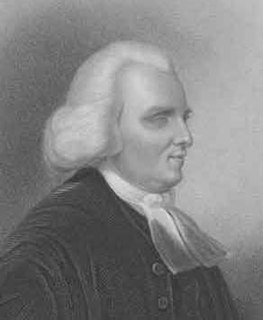
Thomas Blacklock was a Scottish poet who went blind in later life.

William Brodie, often known by his title of Deacon Brodie, was a Scottish cabinet-maker, deacon of a trades guild, and Edinburgh city councillor, who maintained a secret life as a housebreaker, partly for the thrill, and partly to fund his gambling.

Alexander Adam was a Scottish teacher and writer on Roman antiquities.

Alison Cockburn also Alison Rutherford, or Alicia Cockburn was a Scottish poet, wit and socialite who collected a circle of eminent friends in 18th-century enlightenment Edinburgh including Walter Scott, Robert Burns and David Hume.

The Kirk of the Canongate, or Canongate Kirk, serves the Parish of Canongate in Edinburgh's Old Town, in Scotland. It is a congregation of the Church of Scotland. The parish includes the Palace of Holyroodhouse and the Scottish Parliament. It is also the parish church of Edinburgh Castle, even though the castle is detached from the rest of the parish. The wedding of Zara Phillips, the Queen's granddaughter, and former England rugby captain Mike Tindall took place at the church on 30 July 2011. The Queen sometimes attends services in the church when she visits Edinburgh.

Liberton is a suburb of Edinburgh, the capital of Scotland. It is in the south of the city, south of The Inch, east of the Braid Hills, north of Gracemount and west of Moredun.

The Parish Church of St Cuthbert is a parish church of the Church of Scotland in central Edinburgh. Probably founded in the 7th century, the church once covered an extensive parish around the burgh of Edinburgh. The church's current building was designed by Hippolyte Blanc and completed in 1894.

Hippolyte Jean Blanc was a Scottish architect. Best known for his church buildings in the Gothic revival style, Blanc was also a keen antiquarian who oversaw meticulously researched restoration projects.
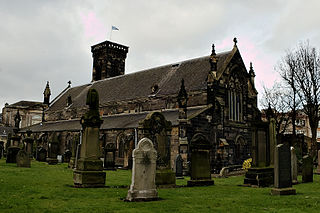
South Leith Parish Church, originally the Kirk of Our Lady, St Mary, is a congregation of the Church of Scotland. It is the principal church and congregation in Leith, in Edinburgh. Its kirkyard is the burial place for John Home and John Pew, the man from whom the author Robert Louis Stevenson reputedly derived the character of Blind Pew in the novel Treasure Island. The church has been repaired, used as a magazine and reconstructed but still looks similar to its appearance on a 1608 seal.

Lady Yester's Kirk was a congregation of the Church of Scotland. The building is located on Infirmary Street in Edinburgh, Scotland, and was formerly one of the foremost churches in the burgh. It is now used as the joinery workshop for the Estates Division of the University of Edinburgh.
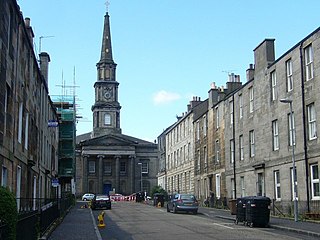
North Leith Parish Church is a congregation of the Church of Scotland, within the Presbytery of Edinburgh. It is serves part of Leith, formerly an independent burgh and since 1920 a part of the city of Edinburgh, Scotland.

Henry Grey (1778–1859) was a Scottish minister in the Church of Scotland and following the Disruption of 1843 in the Free Church. He served as Moderator of the General Assembly of the Free Church of Scotland in 1844.
John Maitland Moir was a priest of the Orthodox Church of St Andrew in Edinburgh, and founder of several Orthodox communities in Scotland. He was Orthodox Chaplain to the University of Edinburgh.
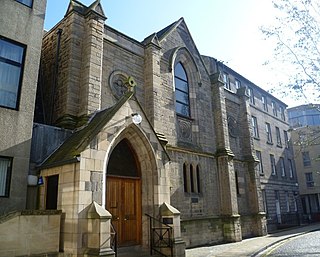
The King Khalid Building is an event space in the Southside, Edinburgh, Scotland, owned and operated by the Royal College of Surgeons of Edinburgh. The building was constructed Roxburgh Free Church in 1847 and converted to its current use in 1982.

Patrick Clason was a Scottish minister who served as Moderator of the General Assembly to the Free Church of Scotland in 1848/49.

East Preston Street Burial Ground is a burial ground in south Edinburgh holding graves from the 19th and 20th century. The graveyard is in the care of the City of Edinburgh Council. It stands at the junction of East Preston Street and Dalkeith Road. The property is a listed building.
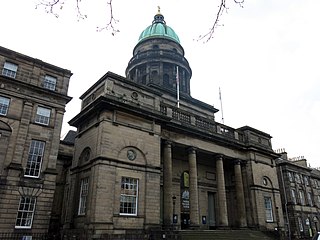
West Register House is a building of the National Records of Scotland, located on Charlotte Square in Edinburgh, Scotland, United Kingdom. The building was constructed between 1811 and 1814 as St George's Church and converted to its current purpose as a records office between 1964 and 1970.

Buccleuch Parish, commonly known as the South Side is a district in south Edinburgh built as an expansion to the Old Town in the 18th century. The area lies between the Old Town and Newington.

The King's Hall is a church in Newington, Edinburgh, Scotland. Constructed as Newington Free Church in 1843, it is now used by Community Church Edinburgh: an independent evangelical congregation.


















